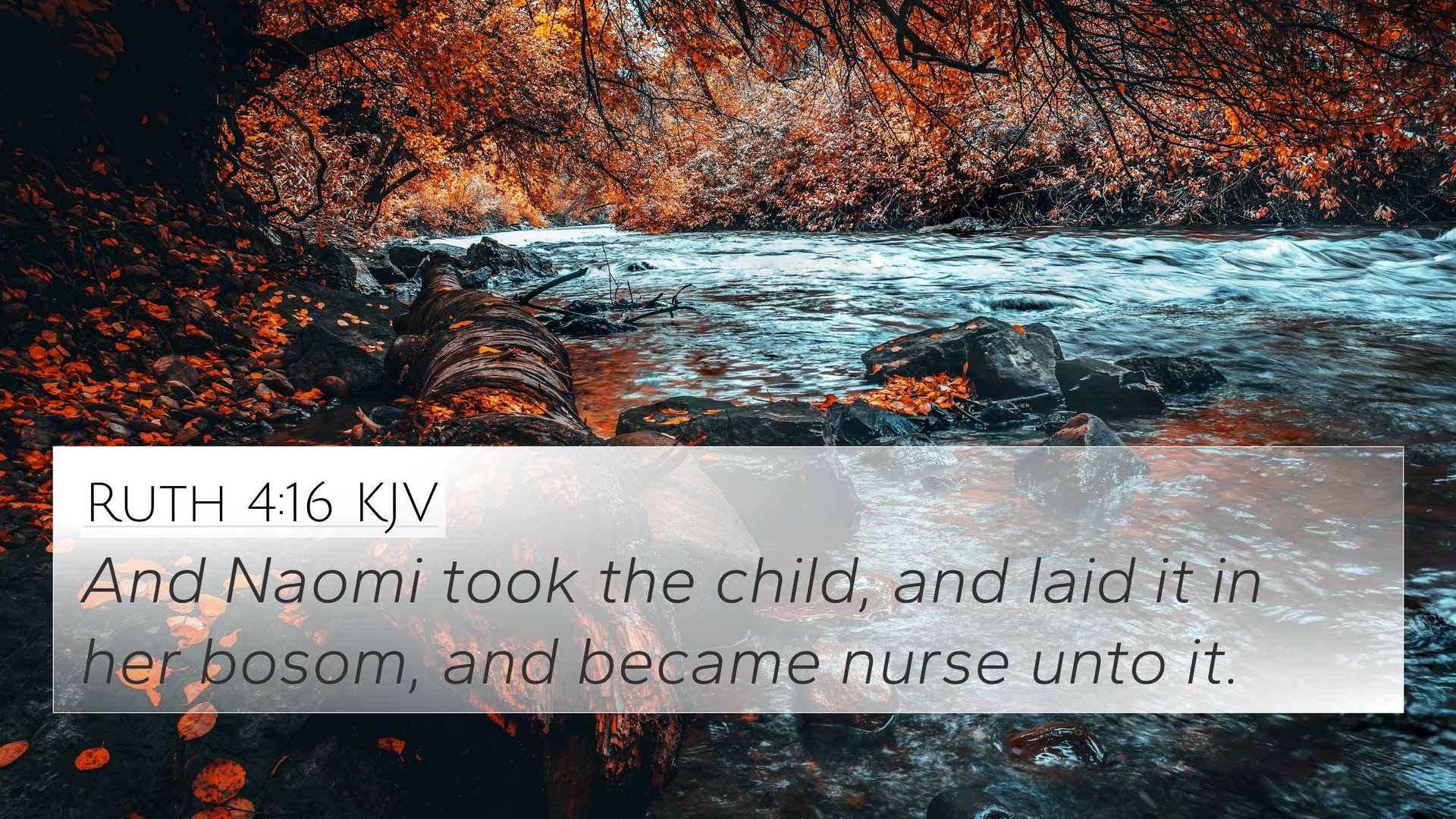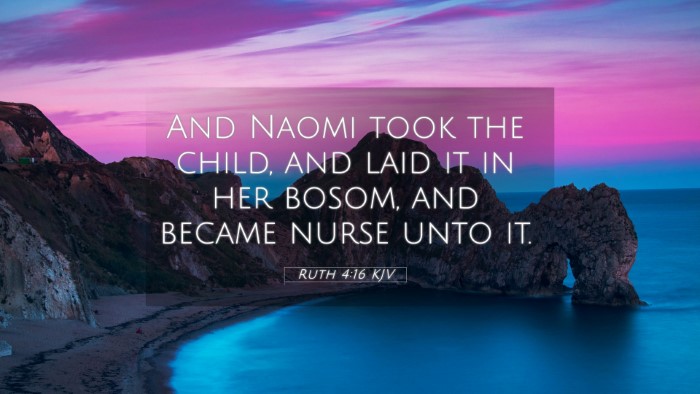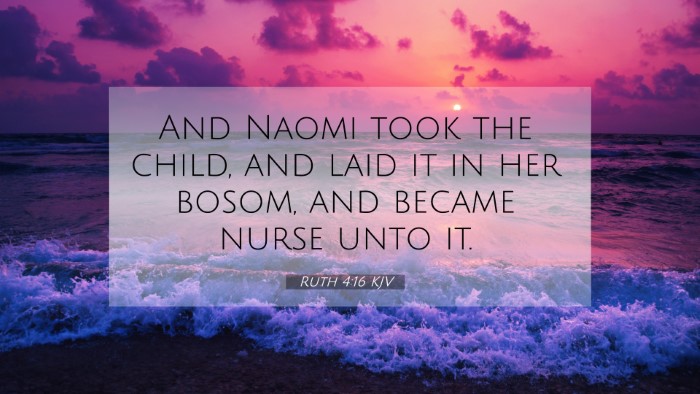Old Testament
Genesis Exodus Leviticus Numbers Deuteronomy Joshua Judges Ruth 1 Samuel 2 Samuel 1 Kings 2 Kings 1 Chronicles 2 Chronicles Ezra Nehemiah Esther Job Psalms Proverbs Ecclesiastes Song of Solomon Isaiah Jeremiah Lamentations Ezekiel Daniel Hosea Joel Amos Obadiah Jonah Micah Nahum Habakkuk Zephaniah Haggai Zechariah MalachiRuth 4:16 Similar Verses
Ruth 4:16 Cross References
And Naomi took the child, and laid it in her bosom, and became nurse unto it.
Uncover the Rich Themes and Topics of This Bible Verse
Listed below are the Bible themes associated with Ruth 4:16. We invite you to explore each theme to gain deeper insights into the Scriptures.
Ruth 4:16 Cross Reference Verses
No cross reference images were found in our system for this Bible passage.
Ruth 4:16 Verse Analysis and Similar Verses
Understanding Ruth 4:16
Ruth 4:16 states: "And Naomi took the child and laid him in her bosom, and became nurse unto him." This verse encapsulates the themes of redemption, family, and divine providence within the narrative of Ruth.
Summary of Key Themes
- Redemption: Ruth's marriage to Boaz serves as a powerful image of redemption. Boaz fulfills the role of a kinsman-redeemer, signifying hope and restoration for Naomi and Ruth alike.
- Familial Bonds: Naomi's acceptance of the child highlights the importance of familial connections. She not only gains a grandchild but also sees the continuation of her family's legacy.
- Divine Providence: The narrative underscores how God's hand is at work in the seemingly mundane events of life, guiding Ruth and Naomi toward their ultimate blessing.
Commentary Insights
Combining insights from public domain commentaries helps us delve deeper into the meaning of this verse:
Matthew Henry Commentary
Henry emphasizes the significance of the child as a symbol of joy and hope for Naomi. He notes that this child not only represents restoration for Naomi but also the continuation of God's promises to His people. The act of Naomi nursing the child serves as a metaphor for spiritual nurturing and the vital role of familial love.
Albert Barnes' Notes on the Bible
Barnes points out that Naomi's actions reflect a shift from bitterness to joy. Her acceptance of the child is indicative of God’s mercies following her earlier afflictions. The commentary highlights the child as a pivotal figure in the lineage of David, ultimately leading to the lineage of Christ, thus emphasizing the theological implications of the event.
Adam Clarke's Commentary
Clarke elaborates on the notion that the child signifies not just personal joy for Naomi but also the greater plan of redemption in God’s ongoing narrative. He suggests that the nurturing role Naomi assumes symbolizes the continuity of faith through generations, where the legacy of love and care influences future families.
Cross-References and Related Verses
This verse is richly connected with several other Bible verses that enhance its understanding:
- Ruth 1:16: "Where you go, I will go; and where you lodge, I will lodge." - Ruth's commitment to Naomi reflects the deep relational ties that carry over to this moment.
- Genesis 38:29: The birth of Perez symbolizes the significance of familial lines and highlights redemption through unexpected circumstances.
- Psalm 127:3: "Children are a heritage from the Lord, the fruit of the womb a reward," - this verse parallels the blessing of children as seen in Naomi’s life.
- 1 Samuel 1:27: Hannah’s dedication of her son Samuel to the Lord reflects another significant maternal bond and the importance of children in God’s plan.
- John 1:14: "And the Word became flesh and dwelt among us," - indicates the ultimate fulfillment of redemption found in Christ, stemming from the narrative begun in Ruth.
- Isaiah 61:3: "To appoint unto them that mourn in Zion, to give unto them beauty for ashes," - echoes the theme of transformation from despair to joy, relating to Naomi's experience.
- Matthew 1:5: "Salmon begot Boaz by Rahab, Boaz begot Obed by Ruth..." - links the genealogy of Christ back to Ruth, illustrating the importance of her legacy.
Thematic Connections
Understanding Ruth 4:16 involves recognizing its thematic connections across the Bible. The themes of:
- Faithfulness: The commitment shown by Ruth and later, Naomi, reveals a deeper truth about faithfulness in relationships with God and each other.
- Redemption and Restoration: The overarching narrative illustrates how personal and communal redemption is central to God's plan.
- God’s Providence: Emphasizing that even in personal loss, God is intricately guiding events toward a greater good.
Conclusion
Ruth 4:16 serves as a significant bridge connecting personal narratives of loss, family love, and divine providence into the greater story of redemption. Through the lens of cross-references, we discern how these themes intertwine with the overarching biblical narrative, reinforcing the connectivity within Scriptures.
Using cross-references can deepen our understanding of Scripture, drawing important comparisons and linking biblical texts thematically. Various resources exist for effective cross-referencing, including diligence in looking through a Bible concordance or implementing a structured Bible cross-reference guide to enhance study and comprehension.


